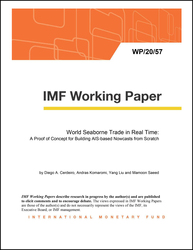
World Seaborne Trade in Real Time: A Proof of Concept for Building AIS-based Nowcasts from Scratch
World Seaborne Trade in Real Time: A Proof of Concept for Building AIS-based Nowcasts from Scratch
READ MORE...
Volume/Issue:
Volume 2020
Issue 057
Publication date: May 2020
ISBN: 9781513544106
$20.00
Add to Cart by clicking price of the language and format you'd like to purchase
Available Languages and Formats
| English |
Prices in red indicate formats that are not yet available but are forthcoming.
Topics covered in this book
This title contains information about the following subjects.
Click on a subject if you would like to see other titles with the same subjects.
Exports and Imports , Economics- Macroeconomics , Economics / General , port visit , machine-learning technique , data from the Automatic Identification System , port call , trade activity , Imports , Exports , Oil , Machine learning , Trade balance , Global
Also of interest
Summary
Maritime data from the Automatic Identification System (AIS) have emerged as a potential source for real time information on trade activity. However, no globally applicable end-to-end solution has been published to transform raw AIS messages into economically meaningful, policy-relevant indicators of international trade. Our paper proposes and tests a set of algorithms to fill this gap. We build indicators of world seaborne trade using raw data from the radio signals that the global vessel fleet emits for navigational safety purposes. We leverage different machine-learning techniques to identify port boundaries, construct port-to-port voyages, and estimate trade volumes at the world, bilateral and within-country levels. Our methodology achieves a good fit with official trade statistics for many countries and for the world in aggregate. We also show the usefulness of our approach for sectoral analyses of crude oil trade, and for event studies such as Hurricane Maria and the effect of measures taken to contain the spread of the novel coronavirus. Going forward, ongoing refinements of our algorithms, additional data on vessel characteristics, and country-specific knowledge should help improve the performance of our general approach for several country cases.
Copyright © 2010 - 2026
Powered by:
AIDC



